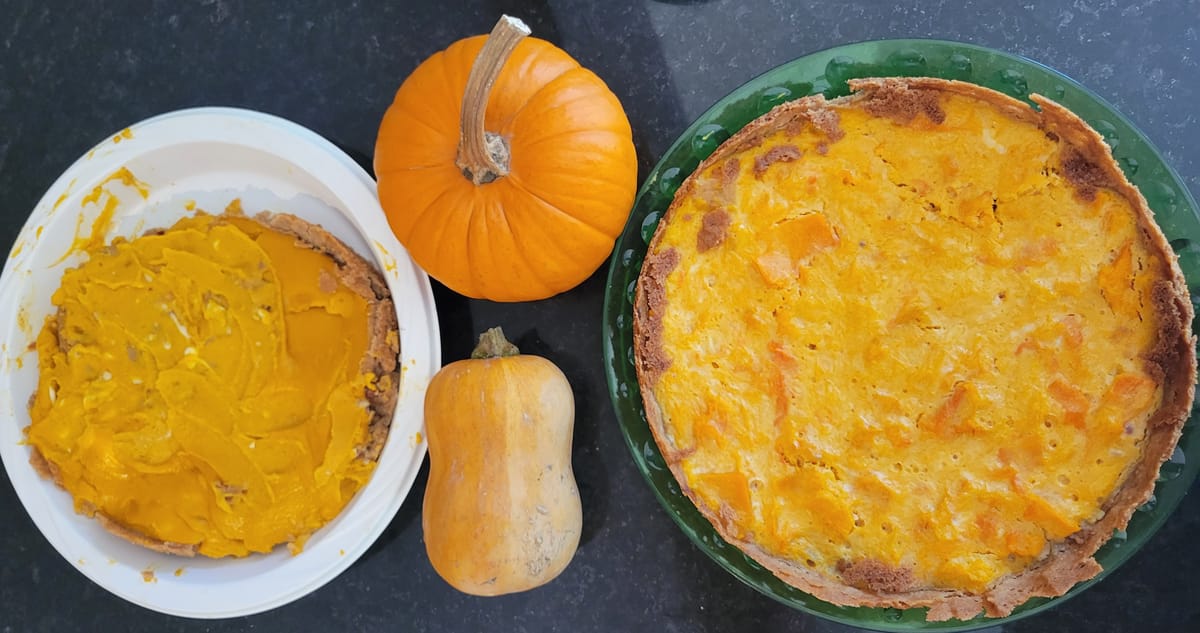On My Plate: "Pumpkin" Pie
Pumpkins make their appearance this time of year, between Halloween carving and Thanksgiving pie.

Pumpkins make their appearance this time of year, between Halloween carving and Thanksgiving pie. Pumpkins are typically marketed either as carving (thin shell with a grainy and stringy flesh, or as pie (smaller with a smoother meatier flesh).
For last week’s MOON Co-op annual owners meeting, I baked two “pumpkin” tarts. I prefer tarts, because their shells are thinner, crunchier and less doughy than pies. One tart was made with organic pumpkin puree and the other with a local butternut squash that I baked and mashed. Other than the puree, I used identical recipes for the two tarts.
I’ve tried baking with the mashed flesh of a pie pumpkin, but the process is extremely bothersome, and the result is bland and watery, so I opted for canned pumpkin puree this year. I used Farmer’s Market Organic Pumpkin Puree, which is available in Oxford at Kroger, MOON Co-op and Walmart.
This recipe is adapted from Patricia Wells, an American food writer who lives in France. Grease the bottom and sides of a 9-inch springform pan. Melt nine tablespoons of unsalted butter and mix with one-quarter of a cup of sugar, a pinch of salt and one-quarter of a teaspoon each of almond and vanilla extracts. Add 1 1/3 cups unbleached pastry flour to form a soft cookie-like dough. Transfer the dough to the pan, pressing the dough evenly into the bottom and sides. Bake the shell for 12 minutes at 375 F.
Remove the shell from the oven and sprinkle one-quarter of a cup of finely ground almonds on it. In addition to imparting a nice flavor, the ground almonds keep the shell from getting soggy when the filling is added.
For the filling, mix one pound of mashed pumpkin or squash, half a cup of creme fraiche, one egg, two tablespoons of honey, and one-quarter of a teaspoon each of almond and vanilla extracts. Pour the filling into the shell and bake for 25 minutes at 375 F. Place on a wire rack and remove from the pan when cool.
In appearance, the result was no contest. When transferred to a serving plate, the tart made with butternut squash retained its structure, whereas the tart made with pumpkin fell apart. Canned pumpkin turned out to be just as watery as mashed baked pumpkin. The taste test proved to be a tie. No one expressed a preference for one over the other.
Libby’s, which accounts for almost 90% of the world’s canned pumpkin market, works with farmers to grow a proprietary variety called Dickinson. Libby’s pumpkin canning factory is in Morton, Illinois. Not by coincidence, that state is responsible for 34% of fresh pumpkins and 98% of processed pumpkins.
Turns out that Libby’s Dickinson “pumpkin” is actually a variety of butternut squash. The U.S. Food and Drug Administration says that labeling Dickinson as pumpkin is legal, because the distinction between a pumpkin and a butternut squash is “murky.” The U.S. Department of Agriculture’s National Agricultural Statistical Service classifies pumpkin as a vegetable. So if you really want pureed pumpkin rather than pureed squash, you need a brand other than Libby’s.
Leaving aside the sketchy advertising, Libby’s has a point. I’ve baked pies and tarts with pumpkin and squash – both fresh and canned – and the squash versions turn out better than the pumpkin versions.
By the way, Oxford’s leading winter squash grower most years, Craig and Sharon Harkrider’s Stoney Hedgerow Farm, will not have any this year. Other local growers are bringing winter squash to MOON Co-op and Oxford’s Farmers Market, but supplies will be relatively low this year.
James Rubenstein is president of the Board of Directors for the Oxford Free Press and professor emeritus of geography at Miami University.




